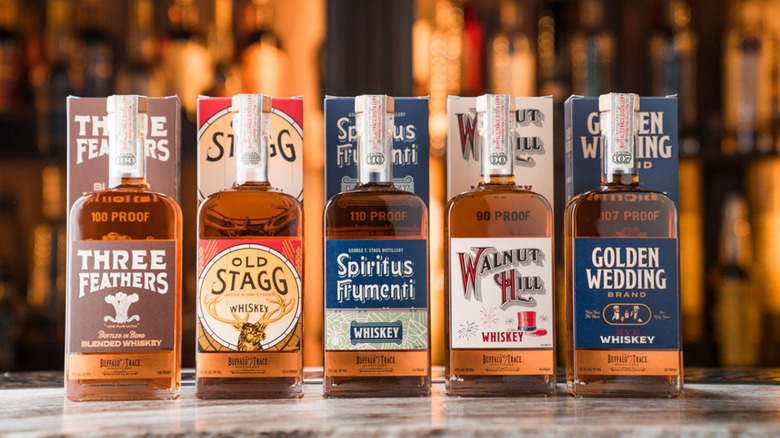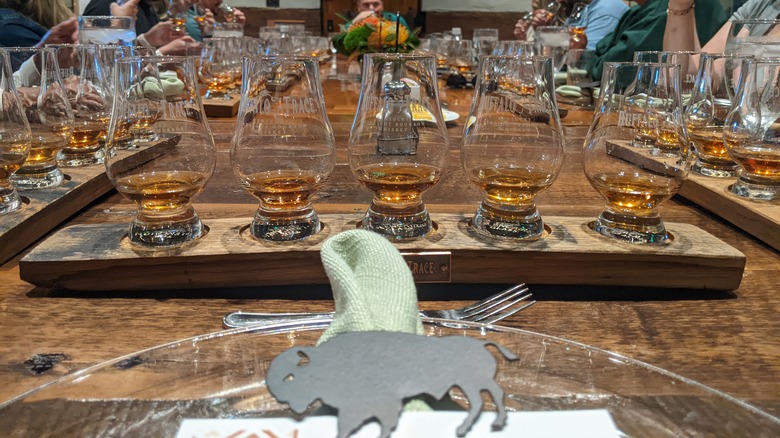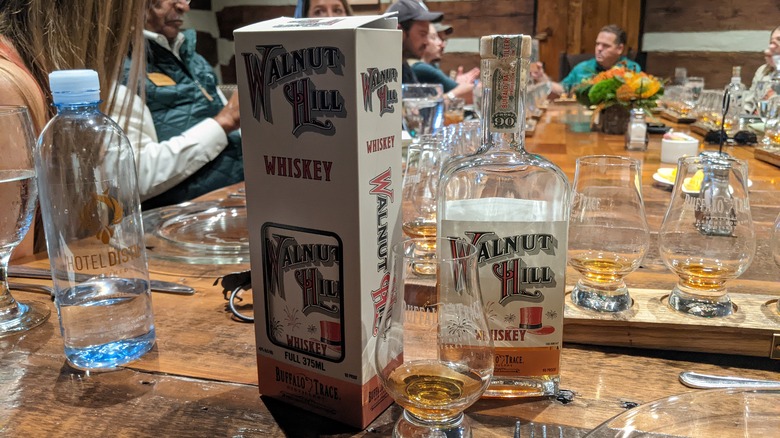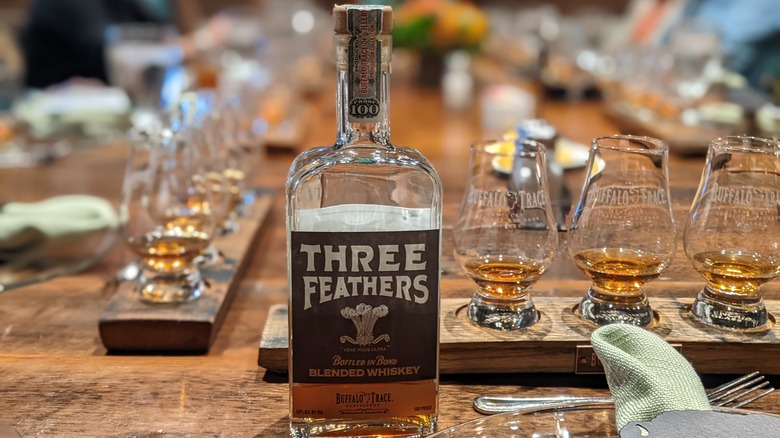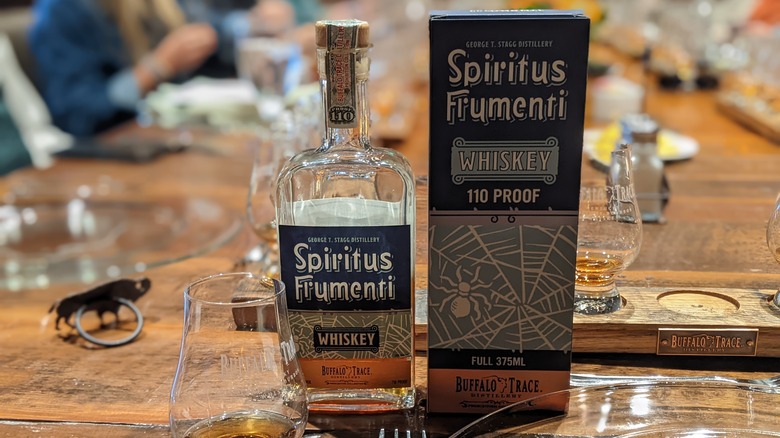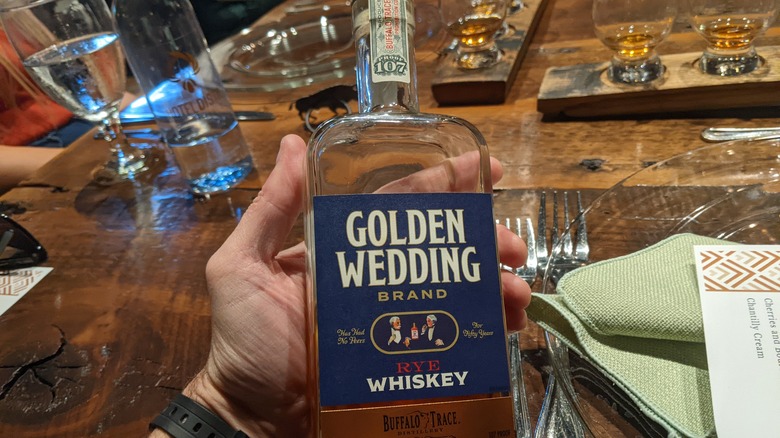We Tried And Ranked Every Bottle In The Buffalo Trace Prohibition Collection
Whiskey is a magical elixir, and sometimes its miracles are a mystery even unto the brand itself. So it was the case with the lost(ish) whiskeys of the Prohibition Era when Buffalo Trace — which was still called the George T. Stagg distillery in those days — had government sanction to produce whiskeys for medicinal use. Buffalo Trace, already running its ongoing Experimental Collection, has announced the first of an annual line resurrecting the bygone labels of the 1920s.
At Buffalo Trace's invitation, we took a trip down to Kentucky, where we toured the facility and sampled some of their best bourbons and newest innovations, including the new Prohibition Collection at a luncheon hosted by Buffalo Trace's master distiller Harlen Wheatley, VIP Visitor Lead (and face of the Buffalo Trace experience) Freddie Johnson, Bourbon Archeologist (yep, it's a real job) Nick Laracuente, and Mark Brown, who recently relinquished the role of CEO and president of Sazerac this spring, but remains on as executive chairman.
They walked reviewers through a flight of these resurrected labels, with their production updated to focus on a satisfying drinking experience rather than any supposed medical benefits — although even in their own time, those whiskeys continued to be marketed under distinctly non-medicinal names, with the exception of Spiritus Frumenti, but we're not here to judge. Wait — yes we are. Here are our reviews of the whiskeys rediscovered, revived, and reinvented by modern-day Buffalo Trace.
How to get the Buffalo Trace inaugural Prohibition Collection
The Prohibition Collection is a very limited release, and it's not publicly known which retailers will be lucky enough to receive allocations. If your local shop generally carries some rare or preferential Buffalo Trace releases, that's the first place to look. Drizly or Caskers are also good starting points if you're looking to cut straight to the results rather than hunt it down or support a specific merchant.
Be warned: the Prohibition Collection ain't cheap. At a thousand bucks for these five bottles, you're going to want to be certain of your completist palate (or collector's shelf) to invest in these, and that's before you realize the bottles are 375 milliliters, not the 750 and up you might expect from a luxury purchase. So with that emptor caveated, let's see if you who intend to drink it see anything that tickles your old-timey fancy from our reviews.
5. Walnut Hill whiskey
Everyone complaining about whiskey makers who utilize MGP production facilities, take note: Walnut Hill was just such a contract job with George T. Stagg Distillery in the 1932 role of Midwest Grain Products. It's a valid means of distillation and tradition in one!
At 90 proof, Walnut Hill's the easiest Prohibition on your liver, which is why much about it is unexpected. This high-rye bourbon is even sweeter than Spiritus Frumenti and with more oak. Buffalo Trace says you can expect a lot of corn in the aroma, but we caught rye through and through: pepper, citrus, bleach. Its fast and thick legs, layer over a waxy viscosity, but with this amount of body, it's a real surprise that they have this kind of motor to the bottom.
Get it on your tongue and you'll find a floral taste closer to the vanilla side of things, but it quickly gives in to chocolate and, yep, walnut on the chew. While we like what we're dancing with here, this one feels vulnerable to voting off the island. It's good, but it never quite stands out from a lot of great bourbons you could get in quantity for much less than $200.
4. Three Feathers blended BiB whiskey
Historically, the contents in Three Feathers have mutated quite a bit since the first known production of the trademark in 1812. From straight rye whiskey to bonded to blended, it presently exists as a 15-year-old whiskey that's both bottled in bond and blended.
Three Feathers presents a nose reminiscent of E.H. Taylor small batch bourbon — a bottle every bourbon collector needs to find — with vanilla and vinegar but swerves into rye, currant, and prune. None of that is surprising, given that this was the point in our meal when Brown revealed that a visit from a former employee had revealed in casual conversation that the distillery had abandoned the old-fashioned sour mashing technique used to make Taylor. The team at Buffalo Trace was able to return to the method, and one wonders if it isn't in play in one of the whiskeys selected by Master Blender Drew Mayville to represent the Three Feathers.
It sips remarkably soft, and we're led to say yet again that 100 to 101 proof so often delivers a really great whiskey from this part of the world. Then comes a nice, slowly spreading burn: one of the most pleasant we've ever encountered. After that, this is the Scotch drinker's American whiskey, with its smokiness and lighter fruit and sugar notes.
Our first taste was a great introduction, though we think this mixture might be best sipped slowly all night from a steep pour, maybe even on the rocks. A bottle this size could vanish fast, so we request a plebian release of whatever went into this blend.
3. Old Stagg whiskey
If you're looking for a new avenue to Stagg territory, this isn't likely to be the cure-all for your woes. While tasty, Old Stagg doesn't tightly resemble Stagg (formerly Stagg Jr.) or George T. Stagg that you're getting Buffalo Trace Antique Collection for a mere $200 — and even if it did, $200 is a common rate for a bigger bottle of regular Stagg than Old Stagg's 375 milliliters.
Now for the good news. This 132.4 (barrel-)proof whiskey is uncut and unfiltered, as with the Staggs you've sought, and it's somewhat of a mystery where it hews from Stagg production as we know it. The collection shares a tight color range, but Old Stagg is in the center of that honey hue. Its legs are the slowest as well, making it the most stoic pour here.
Continuing its steadfastness, the nose is mildly vanilla, but expectedly high in ethanol. Your findings may vary if you have enough time to let it sit and blow off, but ours was still kicking a long while after it was pre-poured for us. Funny enough, we didn't get a lot of fire in the mouth though, where stone fruit, char, and chocolate played with a trace of nut. Hmmm ... maybe this is Stagg after all.
2. Spiritus Frumenti whiskey
The biggest mystery in the batch was what exactly Spiritus Frumenti was, since its name is simply Latin for "spirit of the grain" and used so widely in a pharmacological setting that the government denied Buffalo Trace a trademark on the term by itself. Thus: George T. Stagg Distillery Spiritus Frumenti. Here it's the wheated mash bill beloved of Pappy Van Winkle chasers and Weller clutchers.
A lot of homework went into approximating what traces they could find, and in part, says Brown, these were reclaimed by a friend of a former employee who simply saved all their old labels in a scrapbook. Looking at the design of these bottles, you can see why a person would save them. Varying across styles, each piece of graphic design in this collection, having been updated today off of the original label, is a masterful piece that excites the eye. It's fair to say that the collectability of these bottles will owe as much to their beauty as their contents.
But how about those contents? Spiritus Frumenti is a reddish-gold color, with fast, thin legs breaking closely together. It offers the most variety of the set on its nose, which serves up a side of bacon with the lemoniness pervading the glasses laid out for us. You have to admit that bacon is something different. At this point in the tasting, we'd call Spiritus Frumenti the best flavor, hitting sweet and only a little bit nutty.
1. Golden Wedding rye whiskey
Its color is golden indeed, and Golden Wedding is the most visually distinct whiskey in this line, though again, these are all pretty close in appearance. The name refers to the original joint production of this one with the Schenley Distillery in Pennsylvania (later Canada).
The legs are slow, irregular, and layered, even running long and unbroken the full length of the Glencairn glass. The nose is rye again, with lemon, which is consistent with its mash bill cousins.
The taste is sweeter still, with a brief flare of burn, there's just something nice here that the others almost attain. It seems that the higher the rye, the better the brand, and Golden Wedding proved to be our favorite in the batch. Others present seemed to favor Spiritus Frumenti, which we can agree was a close second. But whichever you pick, we can agree that this kind of historical research and recreation can only be a good thing for the whiskey industry, fostering healthy experimentation.
